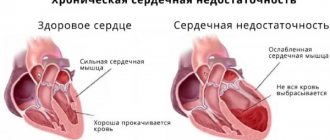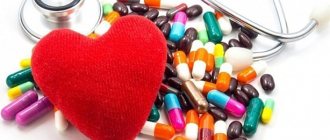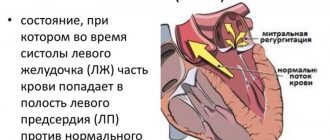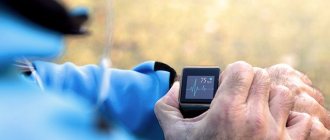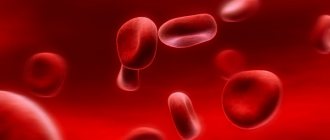Cardiac glycosides are a heterogeneous group of drugs that have a set of similar effects: normalization of contractile and pumping functions of the myocardium, restoration of metabolism, nutrition, and cellular respiration.
Medicines in this group are quite dangerous; if used incorrectly, they can provoke a worsening of the condition, rapid decompensation of heart failure and death in the short term.
Therefore, glycosides are prescribed exclusively by a cardiologist. Even a specialist carefully weighs the peculiarities of physiology and constantly monitors the effect of a particular name in order to quickly correct the course.
Independent use is strictly prohibited to avoid fatal consequences.
Mechanism of action and scope of application
The pharmaceutical effect of cardiac glycosides is complex and complex.
It is precisely this broad ability to influence cardiac structures that is valued in medications of this type, but it is precisely this that has the opposite consequences if taken incorrectly.
Among the mechanisms of action:
- Normalization of nutrition and respiration of the myocardium. The key difference between glycosides is the route by which the effect is achieved.
If other drugs dilate the coronary arteries and restore blood flow, these affect metabolic processes.
Under normal conditions, the efficiency of energy metabolism (roughly speaking, such a term is not entirely appropriate here) is quite small.
Thanks to the use of cardiac glycosides, it grows. Therefore, the basis of the effect is a reduction in the need for blood, oxygen and nutritional compounds due to the maximum use of the volume that is available.
- Increased contractility of the heart. Also a dual process.
Indeed, the pumping function of the muscle structure increases, but at the same time the duration of the stroke itself (systole) decreases, which under certain conditions, with certain forms of failure, can be dangerous.
When using drugs in high dosages, the effect is especially noticeable, which requires careful monitoring of the patient's condition.
- Partially, glycosides have the ability to restore vascular tone in the heart and other organs. But this is not a primary action in importance, so it is considered as additional.
- Diuretic effect. It is soft and causes the rapid removal of excess fluid from the body, thereby reducing the load on the myocardium.
If necessary, specialized drugs can be prescribed, but compatibility with glycosides must be taken into account.
- Antiarrhythmic mechanism. It consists of reducing the intensity of the generation of electrical impulses in cardiac structures and slowing down their conduction.
Also, glycosides have a partial effect inherent in beta blockers. They reduce the sensitivity of special receptors to adrenaline, which minimizes the likelihood of tachycardia.
The pharmacological effects of cardiac glycosides are determined by metabolic processes that are activated when taken.
More actin and myosin are produced, they are responsible for normal myocardial contractility.
There is a direct effect on the vagus nerve, resulting in a reflex reduction in the number of heartbeats per minute. The renal and cerebral arteries dilate.
Glycosides also disrupt the accumulation of potassium in cells due to complex reactions, which determines the alignment of the work of cardiac structures.
With all that said, beneficial effects are observed only with proper use of drugs.
Medicines of this group carry great risks, which makes them unsuitable for unauthorized use, but doctors show maximum attention during therapy.
Attention:
In case of an overdose or the wrong dosage, reverse effects are sure to develop, there is a high probability of death, and urgent medical attention is required.
Symptoms of overdose of cardiac glycosides
Important. Considering the ability of glycosides to accumulate, as well as their slow disposal from the body, with long-term use, an overdose with severe intoxication is possible.
The first symptoms of an overdose of glycosides are gastrointestinal disorders (pain, vomiting, nausea), followed by cardiac symptoms (bradyarrhythmia, tachyarrhythmia, changes in AV conduction, chest pain).
In severe cases of overdose, vision is impaired, changes in color perception, and impaired perception of the size of objects (macro and micropsia) are possible.
Renal dysfunction is manifested by decreased or absent diuresis. Severe nervous excitement and hallucinations are also possible.
Attention. To treat glycoside intoxication, the glycoside that caused the overdose is first discontinued.
Next, it is recommended to administer vitamin K preparations. This is due to the fact that SG significantly reduces the K content in the myocardium. The use of glycoside antagonists on transport ATPases - the drugs unithiol and diphenine - is highly effective.
In order to reduce the concentration of Ca ions in the heart muscle, Ca binding agents are used.
In order to eliminate arrhythmia, the use of lidocaine, propranolol, etc. is recommended.
Short-term remedies
These are medicines based on plant components: lily of the valley and strophanthus. Available in the form of solutions for intravenous administration.
The characteristic features of this group are the rapid achievement of a therapeutic effect, but the result does not last long. About a few hours, after which it fades away.
The reason is low bioavailability - the drug is not absorbed in the intestines.
On the other hand, this is a positive feature. Because the likelihood of an overdose with the correct initial selection is zero.
There is no cumulativeness, that is, the ability to accumulate. Accordingly, the products of this subtype are ideal for short-term use or relief of emergency conditions.
Korglykon
The basis of the composition is lily of the valley. It is considered the safest remedy among all other names.
It has a predominantly cardiotonic effect. That is, it increases the contractility of the myocardium without affecting the frequency of beats per minute.
It does not provoke an overdose even in high concentrations, and practically does not cause side effects, not counting unreasonably prolonged use.
It makes sense to prescribe Corglicon in relatively mild cases of heart failure when the situation is still under the control of the body itself (subcompensation or the first stage to avoid further progression of the pathological process).
Despite the positive description of the drug, there is also a significant disadvantage.
Despite the high safety of the drug, it is much weaker than its analogues, and therefore is not suitable for use in complex clinical situations.
You will have to use high doses. If the result is questionable, the risk of side effects increases significantly. This makes the use of Korglikon unacceptable in many cases and narrows the list of indications.
Strophanthin
The composition is based on the medicinal plant of the same name. Unlike its “brother” in the subgroup, it is characterized by a longer action, about 5-8 hours. Plus or minus, depends on the individual characteristics of the patient’s body and the concentration of the drug.
Available in the form of a solution for intravenous administration. It makes sense to use Strophanthin only in urgent cases, because it is considered a powerful drug.
Specific indications for use include acute heart failure or episodes of cardiac dysfunction as part of a decompensated disorder.
Attention:
The likelihood of an overdose is high, so you need to carefully select the concentration.
If necessary, the medication is administered additionally; in order to avoid dangerous consequences, a larger volume cannot be used artificially for safety reasons.
It makes sense to administer the drug slowly, because rapid infusion develops severe side effects that can be dangerous to health and life, and also increase discomfort.
Long-acting agents
These are drugs based on digitalis. Another medicinal plant. Unlike medications with a short duration of influence, these work for more than a day, some for three days (however, they are not produced today, because massive cases of overdose have been identified).
In this case, there is a cumulative effect. The active component is not completely removed. The concentration increases with further use and also decreases slowly, even after discontinuation.
This makes treatment a particularly challenging task.
Attention:
There is a risk of unobvious overdose. Regular dynamic monitoring is indicated to avoid negative phenomena.
The drugs are available in the form of solutions for intravenous administration and tablets.
The effect occurs somewhat slower when compared with Korglykon and Strophanthin, after about 1-4 hours. Therefore, the medications listed below are not suitable for emergency care. These are products for long-term use.
Digoxin
Basic in the treatment of complex decompensated heart failure. It makes sense to use it in extreme cases.
The drug is too heavy to take in mild clinical situations; an accurate, “pharmacy” calculation of the concentration and dosage for a particular patient is necessary so as not to cause harm.
Usually doctors start with a minimum volume, on the one hand this allows you to titrate the drug (that is, gradually increase the concentration so that the body gets used to it and there are no side effects), on the other hand it makes it possible to gradually reach exactly the concentration when a beneficial effect is achieved.
Then, if necessary, the dose is reduced, again observing the body's response. The task is extremely difficult even for a doctor, not to mention solving it independently.
Digoxin is available in the form of injections and tablets. Jet or drip administration is practiced in advanced cases, in emergency conditions (in some situations, doctors decide to prescribe a name).
If everything is done correctly, there will be only benefits without complications or side effects. But this requires extreme concentration from the doctor, which is relatively rare.
Therefore, the patient should also pay attention to his well-being. Especially in an outpatient setting. For any changes, it is recommended to immediately consult a specialist.
Celanide
Tablet form, not available in solution.
Significantly different from Digoxin. Because it has a milder effect, it is much less likely to cause an overdose or dangerous complications.
It makes sense to prescribe it for subcompensated heart failure or the initial phases of critical dysfunction, if the doctor considers it possible.
However, these are extremely rare situations. The main indication is moderate impairment.
Initially, Celanid was created for long-term use, so the risks are much lower. But this is no reason to relax.
Traditional methods of treating heart failure
Folk recipes have been tested for hundreds of years. These methods involve not only the preparation of various decoctions, but also all kinds of manipulations that can strengthen the heart.
Motherwort
The herb is known to everyone for its sedative properties. It helps the heart restore its normal functioning. The plant contains vitamins and minerals that have a positive effect on the heart muscle.
Motherwort helps fight spasms, has a calming effect and is recommended for use by people who need to strengthen the heart muscle. To prepare the medicine you need to take 1 tbsp. l dry herbs, pour boiling water, leave overnight and strain. Use the medicine 4 times a day, 0.5 tbsp. The ready-made infusion can also be bought at the pharmacy.
Delicious treatment
To prepare the medicine you will need:
- honey;
- prunes;
- dried apricots;
- nuts;
- raisin;
- lemon.
Dried fruits need to be soaked in water in advance, and then twisted in a meat grinder. The entire mixture must be thoroughly mixed and stored in the refrigerator. Use on an empty stomach 1 time per day.
Hawthorn, rosehip
Hawthorn will help dilate blood vessels, eliminate venous congestion, and normalize cardiac circulation. It also cleanses blood vessels from cholesterol. Rosehip contains tannins that help avoid constipation during the treatment process.
To prepare the drink, you will need to take equal parts rosehip and hawthorn and pour boiling water into a thermos. The drink should sit overnight. There is no need to add sugar to the drink and take 1/3 tbsp. 3 times a day.
Cardiac glycosides are drugs that belong to a broad class of nitrogen-free compounds. They have a large list and do not tolerate unprofessionalism on the part of doctors, and also exclude use by the patient without consulting a cardiologist.
Article design: Vladimir the Great
Let's summarize
The list of cardiac glycosides is small. Previously, there were long-acting analogues, like Digitoxin and some similar in name.
You can still find recommendations on how to use them on sites with outdated information.
They were effective for about 3 days, but often provoked an overdose, which was the reason for discontinuation of production. Now it is impossible to find such heavy drugs.
The names of the drugs are determined only by the doctor. As can be seen from the descriptions, all cardiac glycosides are products based on herbal components.
Classification
There is no unified classification of cardiac glycosides. As a rule, SGs are classified according to their origin and duration of action.
The duration of exposure to the drug depends on the ability of the glycoside to bind firmly to proteins, as well as on the rate of its biotransformation and disposal from the body.
Long-acting agents
SGs with a long-term effect and a pronounced cumulation effect (the ability to accumulate during subsequent applications) include a subgroup of foxgloves. Long-acting glycosides, after oral administration, begin to exert their maximum cardiotonic effects eight to twelve hours after administration. The effect of long-term SG lasts for ten days or more.
For reference. After the drugs are administered into a vein, they begin to act within thirty to 90 minutes. The maximum effectiveness of the medicine appears after 4-8 hours.
Of this group of glycosides, the most commonly used preparations are digitoxin and digoxin, obtained from purple and digitalis foxgloves.
Medium-lasting agents
SGs with a medium duration of action include cardiac glycosides obtained from rusty and woolly foxgloves (celanide and digoxin), as well as adonis preparation.
Indications
The reasons for using such difficult-to-use drugs are always serious. An approximate list can be presented as follows:
- Chronic heart failure of advanced stages (sub- and decompensation, 2-3 degrees, respectively). If other drugs are ineffective or as part of systemic therapy with the prescription of other pharmaceutical groups of drugs.
- Acute cardiac dysfunction. When providing emergency care.
- Circulatory failure stages 2-4 with severe breathing problems, ascites (accumulation of fluid in the abdominal cavity) and other dangerous phenomena.
- Supraventricular arrhythmias. Fibrillations and others. Such as multiple extrasystole (when unnecessary, extraordinary contractions of the organ are detected during the period of expected diastole, when the isoline is calm), paroxysmal tachycardia. In this case, glycosides “dampen” the excessive electrical activity of cardiac structures.
As a matter of priority, drugs of this type are not used, because, as always, there is a possibility of a heart attack. You can begin administration only after tissue necrosis has been ruled out.
Side effects, drug toxicity
There are cardiac and non-cardiac side effects from the use of drugs in this group:
- Cardiac manifestations:
- ventricular fibrillation;
- AV block;
- sinus arrhythmia;
- tachycardia;
- polytopic tachycardia;
- sinus bradycardia.
- extracardiac manifestations:
- nausea;
- anerexia;
- vomit;
- deterioration of visual acuity;
- insomnia.
Drug poisoning can occur due to overdose.
Precautions when treating with glycosides
There are no special rules for the use of medications when it comes to short-acting drugs. It is enough to follow the described dosage, taking into account the patient’s condition.
Questions begin when using prolonged forms with a cumulative effect; they work for a long time, so a clear scheme is required.
- At the initial stage, the concentration is gradually increased until a positive effect is achieved. This may take time.
Emergency cases where doctors decide to use long-acting agents are not considered. Here, minutes count, so experience and understanding of the situation play a big role.
- Next comes the stage of maintenance therapy. If you continue to use the medicine at the same concentration, there is a high risk of overdose.
Because the active substance will continue to accumulate. It is necessary to gradually reduce the volume of use until a lasting result is obtained. Again, rapid withdrawal is unacceptable, as is an unreasonable underestimation of the dosage. It is possible that all the success achieved will come to naught.
The key rule for the patient is that cardiac glycosides are used only with a doctor’s prescription and strictly according to the described regimen.
Amateur activity will most likely end in death from complications or severe disability. Any changes in well-being also require a second consultation with a cardiologist.
Fast acting
More details about each group, features of action, indications, contraindications.
“Strofanthin” and other drugs that belong to the group of fast-acting glycosides have the same mechanism of action and purpose, mainly acute failure or chronic decompensation.
When used orally, most of it is not absorbed from the digestive system and is excreted from the body without reaching a therapeutic dose in the blood. Therefore, the intravenous method of administration is used.
The effect is achieved quickly, within 5-10 minutes, maximum after 15-30 minutes, lasts about a day. It practically does not accumulate in the body, so cases of overdose are less common than with long-acting drugs.
It has a different effect on the effect when combined with drugs of different groups, and has a number of side effects. In case of intoxication, a special antidote (unithiol or EDTA) is prescribed, the drug is discontinued or prescribed with long pauses between doses, and the manifestations are relieved symptomatically.
Symptoms of heart dysfunction
Contraindications
Grounds for refusal to use:
- Acute myocardial infarction.
- Renal failure in the decompensated phase.
- Individual intolerance to the drug.
- Polyvalent (systemic) allergy to many medications. Requires careful use.
- Disturbances in electrolyte metabolism, concentrations of certain microelements and their ions (low potassium with high blood calcium).
- Bradycardia (decrease in heart rate to 55 beats or less).
- Atrioventricular block, disruption of the conduction system of the heart.
Cardiac glycosides. Drug names
Of course, names may change and their list may be supplemented as new developments are introduced. However, to proven and
Working drugs include the following:
- Digitoxin preparations – Cardigin, Digofton, Digimerk, Digitoxin.
- Rev. Digoxin is produced under the names Digoxin, Digoxin Grindek, Novodigal.
- Rev. Celanide is produced under the name Celanid, Lanatoside C.
- Rev. strophanthin – Strophanthin K, Strophanthin G.
- Rev. Korglikon - Korglikard, Korglikon.
Indications for use
Cardiac glycosides are most often used for:
- AHF and CHF,
- tachysystolic atrial fibrillation,
- paroxysmal tachycardias,
- atrial flutter,
- nodal AV arrhythmia.
Contraindications
Cardiac glycoside preparations are not used for:
- the patient has bradycardia ,
- AV blockade,
- severe cardiosclerosis,
- angina pectoris
- myocardial infarction,
- endocarditis,
- myocarditis,
- SVC syndrome,
- hypertrophic cardiomyopathy,
- valve defects,
- cardiac tamponade.
An absolute contraindication is also intoxication with cardiac glycosides.
What to do in case of overdose
Excessive concentration of the drug will lead to a triad of problems: arrhythmia, a drop in heart rate, and worsening cardiac failure to critical levels. All these are factors in the onset of early death.
In case of an overdose of glycosides, an ambulance must be called; recovery is indicated in a hospital; very little can be done on an outpatient basis.
The hospital is already taking the following measures:
- The drug is discontinued.
- Potassium-based drugs (Asparkam, Panangin or others) are administered intravenously.
- The medication itself is neutralized by Unithiol.
- Arrhythmia is eliminated with Quinidine or Amiodarone, if necessary with other names.
- Sorbents are introduced.
- Normalization of the conduction of electrical impulses is also required. In this case, Epinephrine and Atropine will help.
Fortunately, with a properly selected course or single dosage, such dangerous situations rarely occur.
Origin, medicinal effects and names of drugs
Glycosides are substances of plant origin that are found in plants growing, including on the territory of the Russian Federation:
- Digitalis,
- Adonis,
- Lily of the valley,
- Jaundice.
Drugs in this group contain two main components that perform different functions, pharmacokinetics and pharmacodynamics:
- Sugar part, glycone. A component that, depending on the composition of the drug, ensures absorption, transportation, protein binding, metabolic rate, and lipophilicity.
- Non-sugar part, aglycone. It is this substance that determines the mechanism of action, the cardiotonic effect.
Depending on the plants included in the composition and their lipophilicity, medications are distributed according to indications. The most lipophilic drugs quickly combine with proteins and are able to cumulate (accumulate) in the body due to adipose tissue, therefore they are indicated mainly for chronic failure (CHF).
The cardiotonic effect is the ability to enhance cardiac contractility, increase systole power, and increase performance. This improves the patient’s condition and increases blood flow to the organs.
Classification
Two main groups, classification:
- "Digoxin", "Digitoxin", instructions for use - lipophilic prolonged preparations and
- "Korglikon", "Strofanthin" - lipophobic, short-acting.
Video: why people don’t like to prescribe glycosides
Read further:
Glucose in case of alcohol or food poisoning: adults and children
At the first sign of a cold
How to use sodium thiosulfate to cleanse the body?
The therapeutic community is a path to health
Quality care for older people
Article rating:
Share with friends:
You may also be interested in:
Overdose of Diclofenac: symptoms and consequences of poisoning
What to do in case of overdose of acetylsalicylic acid (aspirin)
Zyrtec overdose - symptoms and first aid for children and adults
Cardiomagnyl - what kind of drug, overdose and poisoning
Bad influence
In addition to the accumulation of FH in the body, there are side effects that can frighten the patient. Let's talk about those that can be felt; let the doctor deal with the rest.
- Breasts are growing, and I'm a man. In medicine this is called gynecomastia. Most often it causes panic in men, as the breasts begin to enlarge and hurt. Women are less likely to pay attention to this, but in vain.
- And food is not food. Nausea, diarrhea, vomiting and anorexia are frequent companions of any pharmacological products, SG is no exception.
- Don't believe what you see. While taking SG, visual impairment may occur. The patient may see the world in a yellow color, complain of blind spots or “spots”, make mistakes in judging the size of objects, or notice deterioration of vision in general.
- Sad and happy. Depression or euphoria are two extremes of influence on the nervous system, both are possible. The patient most likely will not notice the state of psychosis, but almost no one experiences it.
- Overwork. Sleep disturbances may be accompanied by fainting. In a milder version, the patient will experience dizziness, headache and fatigue.
If side effects disturb your peace of mind, you must inform your doctor about this.
Note. Fear of side effects is not a reason to refuse treatment. For example, a side effect of cold medicine is cardiac arrest, but this stopped few people.
Deterioration of vision is a clear reason for cancellation
Prognosis, treatment results
Treatment with digitalis is a complex process. Prescribed to patients whose pathology is not controlled by other drugs. It is necessary to very carefully select the dose and monitor the patient’s condition.
If all conditions are met, the patient can count on a good prognosis for life. In case of frequent violations of the course rules, frequent side effects, if it is necessary to change the treatment, the recovery process is also disrupted. Whether the prognosis is favorable depends on many factors.
Treatment of all types of cardiac dysfunction is a complex, complex process, the correctness of which determines how long and how the patient will live. The task of the cardiologist is to determine which means will most gently and smoothly enhance the work of the heart without aggravating the underlying pathology. If you had to switch to cardiac glycosides, this means that the situation is serious, but not a stalemate, it simply requires greater scrupulousness, attention and responsibility both from doctors and from the patient himself, who must follow all prescriptions impeccably.
Diagnostics in the hospital
To carry out differential diagnosis of this pathology, specialists use the entire range of available capabilities. The clinical picture and corresponding anamnesis in most cases make it possible to make a correct diagnosis in a timely manner. To confirm thoughts about poisoning with cardiac glycosides, an ECG becomes the first assistant to clinicians. There are enough signs of the development of this formidable pathology:
- arcuate change in the ST segment and decreased amplitude with T wave inversion;
- a sharp change in heart rate when taking cardiac glycosides, characterized by the presence of extrasystoles, sinus bradycardia and, in rare cases, atrial flutter;
- development of atrial or ventricular tachycardia with the presence of complete AV block;
- alternation of positive and negative QRS complexes suggests the possible occurrence of bidirectional ventricular tachycardia.
An overdose of cardiac glycosides is characterized by the presence of one or more of the above signs on the ECG.
Laboratory services can also contribute to obtaining a complete and final diagnosis. Elevated levels of cardiac glycosides in the blood and hypokalemia will help confirm the assumption of poisoning with these drugs.
We recommend reading the article about right ventricular heart failure. From it you will learn about the causes of the disease, signs and symptoms of heart failure, diagnosis and treatment.
